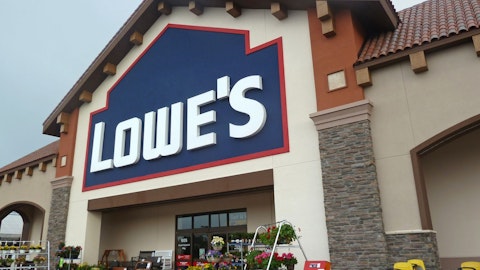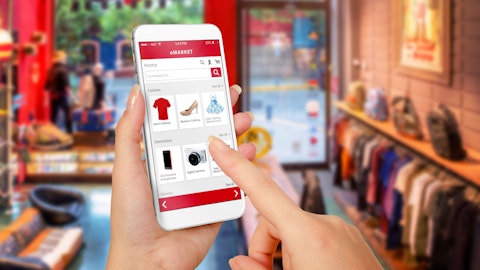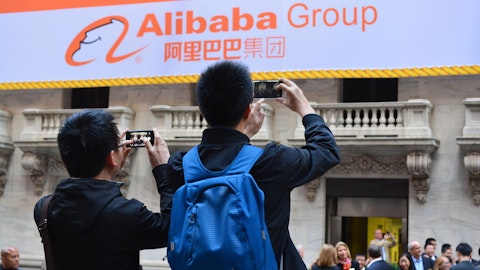Lowe’s Companies, Inc. (NYSE:LOW) Q2 2023 Earnings Call Transcript August 22, 2023
Lowe’s Companies, Inc. beats earnings expectations. Reported EPS is $4.56, expectations were $4.49.
Operator: Good morning, everyone and welcome to Lowe’s Companies Second Quarter 2023 Earnings Conference Call. My name is Rob and I will be your operator for today’s call. As a reminder, this conference is being recorded. I’ll now turn the call over to Kate Pearlman, Vice President of Investor Relations and Treasurer.
Kate Pearlman: Thank you and good morning. Here with me today are Marvin Ellison, Chairman and Chief Executive Officer; Bill Boltz, our Executive Vice President, Merchandising; Joe McFarland, our Executive Vice President, Stores; and Brandon Sink, our Executive Vice President and Chief Financial Officer. I would like to remind you that our notice regarding forward-looking statements is included in our press release this morning, which can be found on Lowe’s Investor Relations website. During this call, we will be making comments that are forward-looking, including our expectations for fiscal 2023. Actual results may differ materially from those expressed or implied as a result of various risks, uncertainties, and important factors, including those discussed in the risk factors, MD&A and other sections of our Annual Report on Form 10-K and our other SEC filings.

Photo by Heidi Fin on Unsplash
Additionally, we will be discussing certain non-GAAP financial measures. A reconciliation of these items to U.S. GAAP can be found on the quarterly earnings section of our Investor Relations website. Now, I will turn the call over to Marvin.
Marvin R. Ellison: Thank you, Kate and good morning, everyone. For the second quarter, comparable sales declined 1.6%. Our results were driven by strong Spring recovery, combined with continued growth in Pro and online, which helped to offset softer DIY discretionary spending and 160 basis points of pressure from lumber deflation. Q2 also reflected the importance of our ongoing investments in our total home strategy and despite an uncertain macro, these investments are paying off with positive comps in Pro and 6.9% comparable sales growth online as we continue to improve our omni-channel experience. We’re pleased that our core Pro customer to small to midsize Pro remains resilient and continues to respond to our expanded national brands, MVPs Pro rewards program, and enhance online tools.
In our most recent survey, nearly 75% of Pros reported healthy project backlogs and lead volumes remained consistent with recent quarters. This quarter, we launched a new same day delivery option on lowes.com and our mobile app powered by OneRail, enabling us to tap into their network of 12 million drivers to deliver directly to Pro job sites and consumer homes in a matter of hours. This new capability allows us to leverage our 1700 plus store footprint to make those much needed last minute deliveries to Pro job sites saving them both time and money. Our expanded same day delivery capability is the latest of many examples of how we are meeting our customers where they are and making home improvement shopping faster and more convenient for both Pro and DIY customers.
We’re also making strides in the rollout of a market delivery model for big and bulky products, with 13 geographic regions now supporting more than 1200 stores and we’re on track to complete the initial rollout by the end of the year. As we invest in what will drive our future growth, we remain disciplined in improving productivity through our perpetual productivity improvement initiatives or PPI. In the second quarter operating margin expanded 18 basis points, leading to diluted earnings per share of $4.56. A common misperception we hear is that our productivity journey must be close to this end, as we’ve driven significant operating margin leverage since beginning our transformation five years ago. But the reality is, we still have a lot of opportunity ahead.
We’re in the final phases of sun-setting, our 30-year-old operating system, in addition to the productivity benefits of using intuitive touchscreens instead of hard to navigate green screens, this conversion gives us the modern foundation needed to quickly build and scale new omni channel capabilities for the future. And we also continue to leverage our penetration Lowe’s stores to drive sales productivity. We run these stores with low expense base and the rest of our portfolio and our ability to generate outsized operating margin and leverage on sales growth is unique. Specifically, the expansion of our rural product assortment, combined with the implementation of our PPI initiatives make our rule in most stores a competitive advantage for our company.
Beyond the productivity initiatives underway in stores, our leaders across all functional areas are executing against dozens of PPI work streams to deliver sustained operating margin improvement. One example of this is in our supply chain where we are driving greater throughput with new mobile applications combined with automation and robotics to improve productivity, maximize speed, and minimize damages. And we’re piloting a new brake pack process, which leverages automation to break down cases five times faster, making it far more efficient to replenish stores. And as we drive productivity we also continue to focus on sustainability as they to often go hand in hand. And we recently published our 20th Corporate Responsibility Report, spotlighting our path to net zero emissions along with our investments in our associates and communities.
As we speak with investors, many of your questions have centered on the macro environment. And as a reminder, the two strongest demand drivers of our business are real disposable personal income, and home price appreciation, and there are most supportive of demand when they pull in tandem. Home price appreciation has slowed, but it’s still up 35% versus pre-pandemic, while real disposable income has been pressured by persistent inflation and elevated interest rates. But on a positive note, over the past quarter growth in real disposable income started to improve and realign with long-term trends with growing wages surpassing inflation for the first time in two years. Consumer sentiment has also improved slightly but remains below pre-pandemic baselines, and inflation concerns linger.
However, improvements in sentiment typically must be sustained for a period of time before that translates to consumer spending. As a result, home improvement shoppers remain cautious with their spend especially big ticket discretionary purchases, and are more focused on smaller repair and maintenance projects. These trends are consistent with our expectations and reinforce our outlook for a relevant market to be down mid-single-digits in the second half of the year, with our sales continuing to outpace the market by 100 to 200 basis points. Looking ahead, it’s encouraging to consider that home improvement projects are typically postponed rather than cancelled. And home improvements spend as a percentage of home equity is below the historical average, a positive indicator for medium term demand as consumer sentiment improves.
The aging housing stock will also draw remodel and repairs combined with other favorable trends like millennial household formation, aging in place, and persistent remote work. All of these factors continue to make us bullish on the mid to long term outlook for our industry. In closing, we remain a customer centric company focused on our daily execution, while also ensuring we continue to make the right investments to take share in any macro environment. Our total home strategy is resonating with our Pro and DIY customers alike and we are confident in our ability to deliver in the short and long term. As I’m out visiting stores each week I continue to be impressed by hard working frontline associates. And I’d like to thank each of them for their commitment to Lowe’s and their communities.
And with that, I will turn the call over to Bill.
William P. Boltz: Thanks Marvin and good morning everyone. Our second quarter comparable sales were down 1.6% slightly above expectations. We successfully recovered 300 million of delayed seasonal sales from Q1 due to the late start to spring, 50 million more than anticipated. We saw growth in rough plumbing, building materials, paint, seasonal and outdoor living, lawn and garden, and hardware as we captured these Spring sales and continued to see solid broad base Pro demand. These factors partly offset 160 basis points of lumber deflation, as well as continued pressure on big ticket DIY discretionary demand that Marvin mentioned earlier. In hardlines, we drove broad based sales growth driven by our stronger than expected spring recovery.
Lawn and Garden was a standout category achieved in partnership with our live good vendors, who helped us effectively respond to changing weather patterns and stretch Spring into the summer months. We saw an increase in smaller, instant gratification projects that improve outdoor spaces at an affordable price like landscaping projects and pre-potted plants. Seasonal and outdoor living also benefited from the weather recovery, where we saw momentum in outdoor power equipment, specifically in riders with the strength of our exciting products from John Deere and Aaron’s, along with the battery powered equipment from the strength of ego, cobalt and craftsman. And we are pleased with our strong seasonal sell through putting us in a better inventory position than last year as we move into the second half.
Hardware was another top performing category this quarter as our associates drove attachments alongside the higher lumber units and leaned into fastening with key brands like Specs, GRK, Power Pro #1 and Facia Master. In tools, we started the rollout of Klein Tools, the number one tool brand for electricians and HVAC professionals. We’re excited about the launch of this brand, which is returning to Lowe’s after nearly 15 years. As part of this launch, we will offer the largest assortment of Klein Tools anywhere in the home improvement retail channel between handtools, storage, safety and electrical products in store and online, positioning us as the go to retailer for these brand loyal customers. Within home decor, paint delivered the strongest comp performance this quarter as we gained traction with the Pros who paint.
These Pros are increasingly taken advantage of our MVPs paint rewards program, paint job site delivery, and our new Spec Right Paint designed specifically for Pros. Turning to appliances, we continue to outperform the market. We’ve seen a return to pre-pandemic levels of vendor funded promotions that are pressuring average tickets across the industry. But I’m excited about the traction that we’re gaining as the leading appliance retailer in the U.S. reflected in our unit sales growth, market share gains, and the momentum with our Pro customers once again this quarter. One encouraging trend was the increase in bundled appliance purchases. This was fueled by focused Red Vest associate selling, auto applied supplier rebates, faster fulfillment through our market delivery model, and our improved online customer experience.
Now shifting gears to building products. We continue to see strength in key Pro categories, helping offset the pressure from year-over-year lumber deflation. While lumber deflation pressured our top line by 160 basis points, and our Pro comps by 315 basis points, the category once again delivered the highest unit comp in the company this quarter, reflecting strong Pro demand. Our continued growth in building materials and rough plumbing is another positive indicator of the resilience of the small to mid-sized Pros supported by the healthy backlogs Marvin mentioned earlier. In rough plumbing, we expanded our assortment of Specs products, and added our first battery powered Kobalt drain auger. This is one of several new Kobalt launches this year as we celebrate this private brand’s 25th anniversary.
Our private brands are specked out and quality tested to ensure that they are equal to or better quality than comparable national brands and we continue to see our customers respond to their great quality and value. Our increasing private brand penetration is nicely balanced with a strong lineup of trusted national brands like Bosch, DeWalt, Rubbermaid and Scott’s. Shifting to localization, we completed our rural expansion to roughly 300 stores ahead of schedule this quarter. This includes scaling our store within a store concept with Petco designed to provide a dedicated space for all things pet. While it’s still early, we’re encouraged to see an increasing basket size in these stores and customers are saying that they appreciate the convenience and the ability to reduce the number of stops they need to make.
As Marvin mentioned, our work to optimize our rural stores is one piece of our broader localization strategy designed to drive market share gains, increased productivity and margins. Another highlight this quarter is the growth we’ve driven online as we continue to improve the digital shopping experience and increased conversion. Our launch of same day delivery nationwide on lowes.com and our mobile app is resonating well with our customers. We also introduced a new digital Will This Fit capability that helps customers determine if a refrigerator will fit into their space, and a refined search experience with better recommendations, filters, and featured categories. And our Halloween and holiday sets are already available online positioning us nicely for customers who want to get a jumpstart on decorating.
We’re also encouraged to see better than expected performance for our Lowe’s One Roof Media Network, which is driving increased traffic to lowes.com and generating results that are exceeding the industry average for our suppliers. Our Media Network is one of many merchandising PPI initiatives underway at Lowe’s. The team is constantly working with our suppliers to find ways to take cost out as commodity prices and transportation costs have come down and we continue to enhance our technology and processes to optimize pricing. We’ve also expanded our merchandising and services team or MST to over 30,000 associates across our stores and garden centers, which frees up our Red Vest associates to spend more time serving customers. New this year we are adding MST assistant store managers.
This role will be focused on providing dedicated store leadership for the critical work that this team does. Through their improved service the team is squarely centered on driving sales per square foot productivity in our stores, while creating a better shopping experience for our customers. As I close, I’d like to once again extend my appreciation to our vendors and merchants for their hard work and partnership. Thank you. And I’ll now turn the call over to Joe.
Joseph M. McFarland III: Alright, thank you, Bill and good morning, everyone. I’m really pleased to begin by announcing that we are awarding over $100 million in bonuses for our frontline hourly associates in recognition of their hard work and dedication during the second quarter. Our investments in our associates are paying off as we continue to elevate the customer experience with a 200 basis point improvement in both our DIY and Pro customer service scores this quarter as compared to last year. And we’re seeing strong staffing levels and improved associate engagement as we continue to invest in associate wages and ongoing development through Lowe’s University. As Marvin mentioned, our online comp sales grew 6.9% in the quarter, and roughly half of those orders are picked up in a store.
We continue to unlock productivity through one of our many PPI initiatives by reducing the time to pick these orders by approximately 70% as our associates leverage our omni channel investments, which include mobile devices and order picking carts with mobile printers, to streamline the process. And we’ve enhanced our workforce management tools to better align staffing levels with customer demand. These enhancements are allowing our customers to get in, get what they need, and get back to their projects faster. Looking ahead, we are further enhancing our both experience as we transform the front end of our stores. This includes an expanded staging area, a dedicated pickup desk with improved signage, and new technology that expedites the process.
Now shifting to Pro, we continue to deliver positive comps this quarter despite lumber deflation, and under the leadership of our new Executive Vice President, Quonta Vance, we will continue to expand our online business tools for Pros that allow them to easily generate quotes and track orders as part of the MVP Pro rewards program. As we continue to find ways to save Pros time, this month, we launched our newest online tool, purchase authorization. Until now when Pro sent the crew member to the store to pick up an order, the designated buyer would need to call their team from the checkout line to confirm the order and have it authorized by the store. This could be a time consuming process, taking the Pros time away from their job site, and the associates time away from serving other customers.
Now runners can simply scan a QR code that’s pre-authorized up to a specified amount and check out without having to wait in line at the Pro desk. This solution addresses a pain point for many Pro customers and our Pro desk associates and leapfrogs the competition and we’re encouraged to see that our suite of online tools is resonated with Pros, and adoptions already exceeding our expectations. Now I’d like to spend a moment discussing how we are managing shrink, which is a big responsibility for any retailer, especially in this environment. As expected shrink was in line with last year’s results despite industry wide challenges driven by our proactive customer service, tech driven solutions, industry leading asset protection program, and our penetration of rural stores.
We’re developing radio frequency identification, or RFID technology embedded in power tools to prevent theft. This solution will be largely invisible to customers, but it makes a tool inoperable until it is scanned and purchased. Turning to PPI for perpetual productivity improvement. In store operations, we have a series of exciting initiatives on our roadmap that will continue to deliver productivity for the company. In addition to the omni channel enhancements that I mentioned earlier, we also upgraded the freight flow process for shipments from our distribution centers into our stores and onto the selling floor. Through improved technology, we now have better visibility into how freight is flowing into our stores. This enables us to better match staffing levels with the type of inbound freight, getting the product onto the shelves faster.
These PPI initiatives, combined with our continued investments in our associates have helped us to control our expenses and improve our customer service scores in a down sales environment. Before I close, I’d like to extend my appreciation to our frontline associates in Kentucky, New York, and Vermont who supported flood relief in their communities and to our teams in Hawaii, who are responding to the devastating wildfires. To support the recovery efforts in Maui, we are donating $1 million to provide food, emergency shelter, and release supplies to those affected and are grateful for our frontline associates for going above and beyond to help those on the island with recovery and cleanup. With that, I’ll turn it over to Brandon.
Brandon Sink: Thank you, Joe. Let me begin with our Q2 results. We generated diluted earnings per share of $4.56. Q2 sales were $25 billion. As a reminder, prior year sales included $1.7 billion generated in our Canadian retail business. Results also reflect a $335 million sales headwind and due to the shift in our fiscal calendar as we cycle over a 53-week year. As Marvin mentioned, comparable sales were down 1.6%, which includes approximately 160 basis points of lumber deflation. This pressure was partly offset by a 125 basis point benefit or $300 million of seasonal sales delayed from Q1 due to a late start to Spring. Although the calendar shift pressured total sales growth in Q2, it had no impact on comparable sales as comps are calculated based on weeks 15 to 27 in fiscal 2022.
Comparable average ticket was up 0.3% to prior year. Ticket increases in the majority of our merchandise categories were offset by lumber deflation and more normalized appliance promotions. Comp transactions declined 1.9% driven by continued pressure in DIY discretionary purchases, partly offset by our seasonal recovery. Our monthly comps were down 1.2% in May, 1.6% in June, and 2% in July as the seasonal recovery was concentrated in the first half of the quarter. Gross margin was 33.7% of sales in the second quarter, up 42 basis points from last year. Gross margin benefited from our ongoing PPI initiatives, favorable product mix, and lower transportation costs. These benefits were somewhat offset by costs associated with the expansion of our supply chain network and as expected, shrink was in line with prior year.
SG&A of 16.4% of sales delevered 16 basis points largely due to lower sales related to the shift in our fiscal calendar. Please note that it also includes the benefit of a onetime legal settlement. We continue to tightly manage expenses, adjusting spend appropriately to align with demand, all while still improving our customer service. Also, as you heard from Marvin, Bill and Joe, we are pleased with the ongoing momentum we are experiencing across our portfolio of PPI initiatives, which continue to create significant value for the organization and helped offset the impact from lower sales. Operating margin rate of 15.6% of sales levered 18 basis points, consistent with the expectations we outlined on our last call. The effective tax rate was 24.6%, in line with the prior year.
Inventory ended the quarter at $17.4 billion, $1.9 billion lower than the prior year quarter. U.S. inventory units were down 3% compared to last year as we continue to manage replenishment in line with sales trends. Now let me turn to capital allocation. In Q2, we generated $3.5 billion in free cash flow and returned $2.8 billion to our shareholders through a combination of dividends and share repurchases. During the quarter, we repurchased 10.1 million shares for $2.2 billion. In addition, we paid $624 million in dividends at $1.05 per share, and we announced a 5% increase to $1.10 per share for the dividend paid on August 9th. Capital expenditures totaled $385 million as we continue to focus on high-return projects that support our growth objectives.
Our balance sheet remains healthy, adjusted debt-to-EBITDAR stands at 2.69 times as we move towards our stated target of 2.75 times in line with our BBB+ credit rating. Additionally, we delivered return on invested capital of 27.8%, inclusive of a 750 basis point impact related to transaction costs associated with the sale of our Canadian retail business and the discrete gain we reported in Q1. Now turning to our 2023 financial outlook. As Marvin mentioned, we continue to expect our relevant market to decline mid-single digits this year and to outperform the market by 100 to 200 basis points. As such, this morning, we reaffirmed our full year 2023 financial outlook. We continue to expect 2023 sales in a range of $87 million to $89 billion for the year, representing comparable sales of down 2% to down 4%.
This includes a 150 basis point impact from lumber deflation for the full year. This outlook reflects continued strength in Pro and online, offset by ongoing pressure from DIY discretionary purchases. Specific to our Q3 expectations, we will be cycling over the toughest comparison of the year as we delivered plus 3% comparable sales in the U.S. last year. Given these difficult comps, we are expecting Q3 sales towards the lower end of our full year guide. We continue to expect full year adjusted operating margin in a range of 13.4% to 13.6%, with disciplined expense management and ongoing PPI initiatives, partly offsetting the impact of lower sales volumes. And we are reaffirming our outlook for adjusted diluted earnings per share of $13.20 to $13.60.
As a reminder, our full year outlook for operating margin and diluted EPS excludes adjustments associated with the sale of our Canadian retail business. And finally, we continue to expect capital expenditures of up to $2 billion this year. In closing, I remain confident that the investments we are making in our Total Home strategy are positioning us to grow our market share regardless of the macro environment while continuing to deliver meaningful long-term shareholder value. And with that, we will open it up for questions.
See also Michael Burry Stock Portfolio: 10 Stocks To Buy Now and 11 Most Profitable Biotech Stocks Today.
Q&A Session
Follow Lowes Companies Inc (NYSE:LOW)
Follow Lowes Companies Inc (NYSE:LOW)
Operator: Thank you. [Operator Instructions]. Our first question comes from Chris Horvers with J.P. Morgan. Please proceed with your questions. Mr. Horvers, please proceed with your question.
Christopher Horvers: Thanks, good morning. So my first question is on the top line. What drove the difficult comparisons in the third quarter that you’re not expecting this year? And then as you think about those bigger ticket DIY discretionary categories, how do you see the rate of change in those businesses, are we starting to get to a baseline level that we can grow from, or is that spending pattern still deteriorating?
Marvin R. Ellison: Hey Chris, this is Marvin. I’ll take the first part now, and I’ll let Brandon take the second part. Look, when you look at last year, it’s two different years, two different macro environments, two different sets of consumer sentiments, two different sets of expectations for DIY and Pro customers. I think the key point is that we feel good about the steps we’re taking to grow market share. Regardless of the macro environment, we have a plan to outperform the home improvement market by 100 to 200 basis points, and that’s what we’re focused on. So I’ll let Brandon answer the second part of your question.
Brandon Sink: Yes. Chris, this is Brandon. Let me get into a little detail on Q3 and second half. First, before I do that, let me take care of one quick housekeeping item as it relates to Q2 exit rate. There’s some noise that we saw in the comp spreads across Q2 given the calendar shift that we experienced. And after adjusting those spreads to compare to last year Q2, comps are down roughly 1% in July. Also, when we look at July and August, they’re traditionally lighter volume weeks until we hit the Labor Day fall seasonal period. So looking ahead at Q3 specifically, we are cycling our toughest comparable of the quarter, plus 3 last year in August, the toughest across that quarter, plus 4. And then your question on sort of puts and takes different from Q2.
As we get into Q3, we won’t see the same level of seasonal benefit. Going forward, we called out $300 million there that we experienced in Q2. More modest lumber deflationary pressure in Q3, which sized at about 75 basis points and then continuing to expect pressure in the DIY discretionary spend. And then on the flip side, continued growth and momentum from the Pro business as we expect to outpace DIY. So those are — just to give you some insights as we look at Q2, and how we transition in Q3.
Christopher Horvers: Got it. Makes sense. And then on the gross margin line, I know you had some price cost issues in the first half of this year. As you look ahead, given — is that behind you and as you think about how freight is going to start to roll through the inventory, should gross margin performance improve in the back half relative to the first half? Thank you.
Brandon Sink: Yes, sure, Chris. So gross margin bounced back as we expected. From Q1, we had easier product margin comparables due to prior year timing. The benefits, as you mentioned, the transportation cost relief is now flowing through margin as expected. We also benefited from product mix, and we continue to see great momentum with our PPI benefits across the merchandising portfolio. Those benefits are offset by continued investment in supply chain and the expansion specifically on market delivery. We called out shrink being neutral, as Joe mentioned, continuing to drive tech solutions to manage some of the industry-wide challenges there. And all in, as we look at the full year, we still expect roughly gross margins flat across the year.
So puts and takes there, just like Q2, supply chain expansion, continued pressure from some of the Pro growth initiatives, and then we expect continued benefits across the back half of the year from private brand penetration, supplier claw backs, lower transportation costs, and initiatives that we’re seeing across the pricing portfolio.
Christopher Horvers: Thank you.
Marvin R. Ellison: Thank you Chris.
Operator: The next question is from the line of Simeon Gutman with Morgan Stanley. Please proceed with your questions.
Simeon Gutman: Good morning, everyone. We’re at the halfway point of the year. I was hoping to take stock or diagnose the macro housing, Marvin, you mentioned that, and then also the consumer. Curious how it’s playing out versus your expectation, it feels status quo, but wanted to hear the puts and takes on both sides?
Marvin R. Ellison: Yes, Simeon. Look, I think you summed it up well. For us, when we look at consumer sentiment, I mean, we know that we’re seeing a pullback in DIY discretionary spend. And that’s really for us the kind of the overall theme of how we see the second half of the year. I think the good news for us is we remain really bullish on the mid to long-term view of the home improvement market, and we think it’s still very healthy. I mean I can just give you the traditional data points that really matter, and we think that they’re going to matter not only for home improvement in the mid to long term, but we think this is one of the best retail sectors to be in. You look at home demand, you had 2 million fewer homes than what’s available for sale, the age of homes, 90% of homeowners have fixed mortgage rates in an environment where rates, as you know, are going up.
And when we look at all the things that we’re doing relative to Pro to DIY, we feel really, really comfortable that irrespective of the macro environment for home improvement that we’re going to outperform the marketplace by 100 to 200 basis points. And key examples of why we believe that is when we take a brand like Klein Tools that we have had absent from Lowe’s for almost 15 years, and we can bring back the number 1 brand for electrical and HVAC Pros and be the largest home improvement retail outlet for that brand, that gives us a lot of confidence that our strategy is working, and we’re going to continue to grow market share across Pro and DIY. But the DIY discretionary pullback on big ticket drives our overall modest concerns about the back half.
But even with that, we think we can outperform about 100 to 200 basis points.





